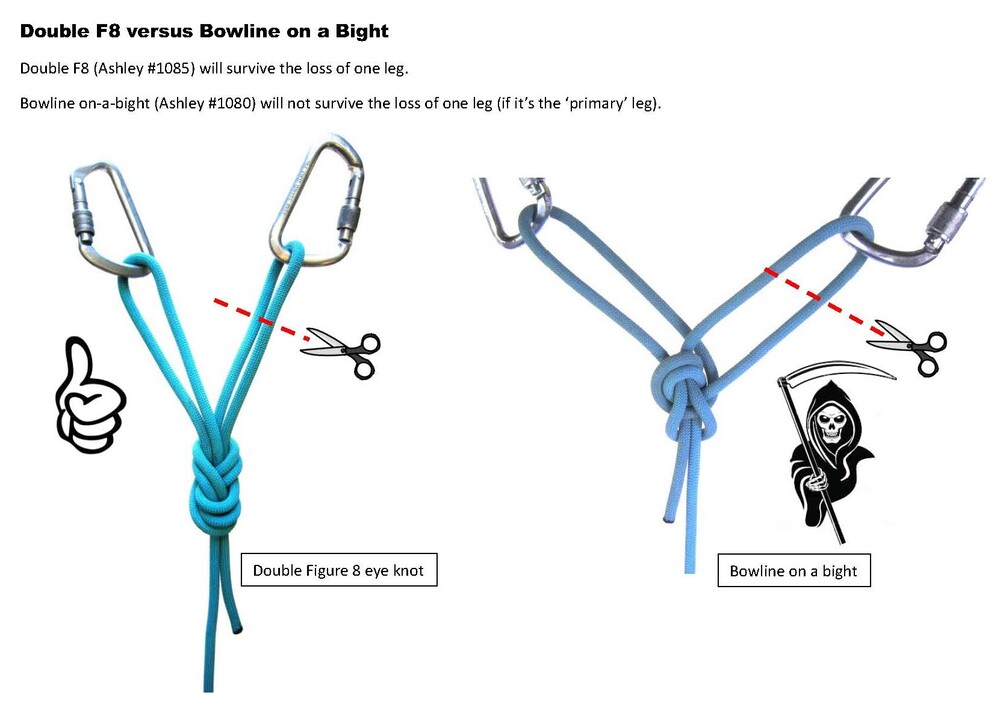Double loop figure eight, not redundant?
|
|
This has been puzzling me for awhile now. I have seen the BHK (double loop overhand on a bight) called out as redundant, and the double loop figure eight being called out at as specifically not redundant due to "the configuration of the not". Quotes are to emphasize that it is the only rational given. The manual in question is by reputable experts in climbing (amga single pitch manual). In this case my assumption is that redundancy here means either one loop could be compromised and the other loop would hold or one of the tail strands could be compromised and the other tail strand would hold. I've tested both with just body weight and it seems the double loop figure eight grabs the bight used to make the double loops as good or better than the BHK which seems like it would tolerate one loop failing just as good. Dunno.. anybody else have better insight or experience there? |
|
|
Larry Morgan wrote: The bunny ears figure eight is not redundant because one strand connects both loops within the knot, if that one strand is abraded or severed both loops immediately fail. The BHK is essentially two independent knots in a trenchcoat, and is thus more redundant. Am I understanding your question? |
|
|
Climbing Weasel wrote: The bunny ears knot is frequently tied as a termination knot for a fixed line. In that context, the fixed line itself is not redundant (we even had a whole thread on this recently...) so worrying about a cut of a specific strand in the knot seems to me to be a little inconsistent. |
|
|
mbk wrote: This isn’t a discussion of rope redundancy. It’s essentially a fixed sliding x in function and redundancy levels. Let’s not get into this again please- it simply is not as redundant as a bhk. |
|
|
Hownot2 video on this. Direct link to the test. Watch the following segment with dyneema to understand the concern better. |
|
|
It is trivially simple to test - tie the knot, connect it to two pieces (bolts, whatever), then unclip one piece. VOILA, it holds. The concern - way overblown IMO - is that there is ONE SPECIFIC spot at the base of the knot which, if severed, will cause failure. I can live with that. |
|
|
Gunkiemike wrote: It’s ok but not best practice. |
|
|
Climbing Weasel wrote: The phrase "Super Good Enough" comes to mind. |
|
|
Gunkiemike wrote: Agreed. But why use something that’s super good enough when you can use something better? |
|
|
Larry wrote; “The manual in question is by reputable experts in climbing (amga single pitch manual). In this case my assumption is that redundancy here means either one loop could be compromised and the other loop would hold or one of the tail strands could be compromised and the other tail strand would hold.“ Hi Larry, in Rock Climbing: The AMGA Single Pitch Manual, the context for the knot was it’s use as an unmonitored master point knot for toproping, versus the BHK (which is redundant), point being that if that critical Achilles heel strand were to cut through, the knot looses its redundancy, so it never became the best practice for that application, even though it presents two loops, and a much cleaner profile, with less abrasion against the rock, than a bulkier BHK. I use the double loop figure eight all the time for anchoring a fixed line to a two-bolt anchor, and it’s almost a rigging standard for that particular application, since you only need two carabiners to pre-equalize off two points. PS> I’m working with the AMGA on a new edition of the book right now. |
|
|
Thanks everyone, makes sense to me now! And Mr. Bob Gaines himself! Thank you sir for taking the time to provide more details. |
|
|
Climbing Weasel wrote: Because sometimes a BFK uses too much rope and the master point is higher than desired. Also, the 2-loop F8 is easier to use after you hang the TR on one leg of a static rope anchor when you're going to tension the second leg of the anchor with (typically) a clove hitch. |
|
|
The Double F8 eye knot (aka 'Bunny ears' by some) is robust enough to withstand the loss of one eye leg. The Bowline on-a-bight is vulnerable to the loss of an eye leg (ie the 'primary' eye leg). https://www.youtube.com/watch?v=z9KTKyFhU-I https://www.youtube.com/watch?v=g4H8fgsxZWg (at 1:34 into the video, he discovers the 'primary eye leg') And this video has been seen by many before: ... No one has ran a series of peer reviewed tests to see what happens when you cut the 'communicating segment' of a Double F8 knot while under load. If I was to speculate (which is risky without test data) - IF the communicating segment was cut, it would be a 50/50 chance of catastrophic failure. Again, this is pure speculation. I have no evidence to back this claim up. |
|
|
A related point is that the bunny ears 8 uses less rope than the BHK. If you're running out of rope for your BHK, switch to bunny ears and get 'er done. |
|
|
Mark Gommers wrote: I was surprised how easily a bowline will slip. This was while rebolting. I’d been working of the rebelay for a few hours so it was quite tight. Slippage occurred at under 200lbs. I had a lot of extra weight, but was also on my feet. I will still use the bowline for rebalays, and to fixe ropes, but am more thoughtful about when. |

 Continue with onX Maps
Continue with onX Maps Sign in with Facebook
Sign in with Facebook





















